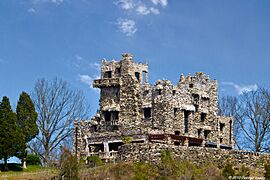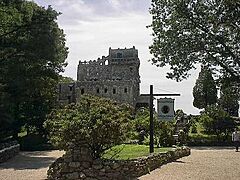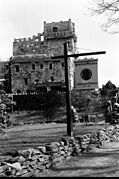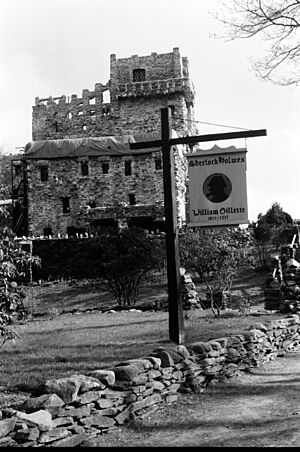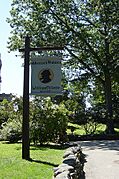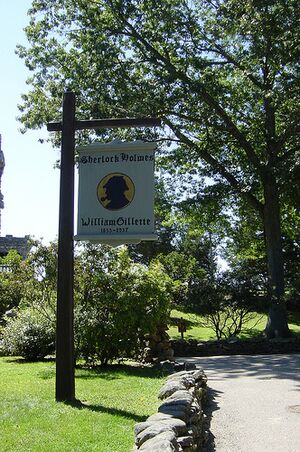Gillette Castle State Park facts for kids
Quick facts for kids Gillette Castle State Park |
|
|---|---|
 |
|
| Lua error in Module:Location_map at line 420: attempt to index field 'wikibase' (a nil value). | |
| Location | East Haddam and Lyme, Connecticut, United States |
| Area | 184 acres (74 ha) |
| Established | 1943 |
| Administered by | Connecticut Department of Energy and Environmental Protection |
| Designation | Connecticut state park |
| Website | Gillette Castle State Park |
|
Seventh Sister
|
|
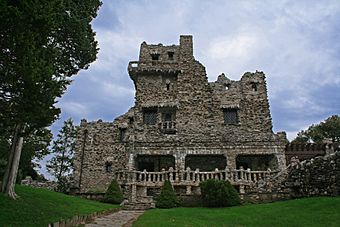 |
|
| Location | 67 River Rd., Lyme, Connecticut |
| Area | 122 acres (49 ha) |
| Built | 1914 |
| Architect | Gillette, William; Porteus-Walker Co. |
| Architectural style | Bungalow/Craftsman, Medieval |
| Website | Gillette Castle State Park |
| NRHP reference No. | 86002103 |
| Added to NRHP | July 31, 1986 |
Gillette Castle State Park is a super cool place in Connecticut, USA. It sits high above the Connecticut River. The amazing castle was designed and built by William Gillette. He was a famous American actor. William Gillette was best known for playing Sherlock Holmes on stage. He lived in this castle from 1919 until he passed away in 1937. The State of Connecticut bought the property in 1943. They paid $29,000 for it.
Contents
Welcome to Gillette Castle State Park!
This park is located at 67 River Road. It's in the towns of East Haddam and Lyme, Connecticut. The castle itself is mostly in Lyme. About 350,000 people visit the park every year. The park was closed for a big restoration project. It reopened in 2002 after four years of work. The project cost $11 million. Today, you can find a visitors' center, a museum, hiking trails, and picnic areas there.
The Story of Gillette Castle
William Gillette's home was first called Seventh Sister. The State of Connecticut renamed it "Gillette Castle" in 1943. It was built between 1914 and 1919. A small addition was finished in 1924. The castle sits on 184 acres of land. This land is on top of a chain of hills called the Seven Sisters.
William Gillette: The Man Behind the Castle
William Gillette was a very creative person. He didn't have a wife or children. When he died, he wanted to make sure his home went to someone special. He didn't want it to go to "any blithering sap-head." He meant someone who wouldn't understand its unique charm. So, the State of Connecticut took over the property in 1943. They renamed it Gillette Castle State Park. The castle was added to the National Register of Historic Places in 1986.
Gillette first planned to build his retirement home somewhere else. But then he saw the cliffs of the Seven Sisters. He was traveling on the Connecticut River in his houseboat, Aunt Polly. He loved the spot and decided to build his dream home there.
Building a Dream Home
Gillette designed the entire castle himself. He watched over every step of the building process. The Porteus-Walker Company helped build it. This company was owned by Gillette's childhood friend, Robert Porteus. The castle looks like a medieval gothic building. Some people call it an "American fairy tale" style. Others say it's a mix of Victorian and Arts and Crafts styles.
The castle has three stories and a tower. It has 24 rooms and is 14,000 square feet big. It was built using wood, cement, and local Connecticut field stone. A strong steel framework supports it. The outside of the home is covered in field stone. Inside, the wood is hand-carved southern white oak. It took 20 workers five years to build it. The construction cost over $1 million back then. Gillette kept adding new things to his home. He worked with local craftsmen to make thousands of improvements.
Inside the Castle: Amazing Inventions!
The inside of the castle is full of cool, unique things. Gillette designed many of them himself. They show off his "creative genius."
Unique Doors and Locks
There are 47 special doors and locks in the castle. Each door has a cool, Steampunk-like latch. These latches are carved from wood. Some doors even have trick locks! They make unlocking them a fun puzzle.
Clever Furniture and Lights
You'll find unique furniture inside. There are built-in couches. There's even a movable table on tracks! The light switches are also carved from wood.
A Secret Balcony and Views
A grand balcony runs along the main room on the upper floor. The walls on the second floor are quite short. Some people think this made Gillette look taller. Guests looking up from below would see him as a bigger figure.
Hidden Bar and Spy Mirrors
Gillette had a hand-carved bar. It opened with a secret latch! He also had a series of mirrors above the great hall. These let him watch visitors from his bedroom. This design helped him spy on guests. It also let him make dramatic entrances!
Fire Safety System
The castle had its own fire safety system. It included a water tower built into the design. This tower fed a special manual fire sprinkler. It was on the second floor, overlooking the living room.
Secret Passages and Rooms
There are secret doors and passages! One secret door near the staircase let Gillette appear suddenly. He could surprise or welcome his guests. There's also a secret room. You can only get to it by pulling down a handle. This reveals a hidden staircase. The room is small and has a fireplace.
Grand Staircase
A beautiful wooden staircase leads to the upper floors. It's a grand sight!
Gillette also decorated his home with Tiffany lamps. These lamps were made from broken bottle pieces. He even had a heated bed! At one time, he shared his home with up to 17 cats. He designed special cat toys for them.
Gillette's Miniature Railroad
Gillette loved his miniature railroad. It was three miles long! It had a complex system of switches, bridges, and a tunnel. Famous visitors like Albert Einstein, Helen Hayes, and Charlie Chaplin rode this railroad. They could ride it around the estate. It even sped along the 100-foot cliffs of the Connecticut River. The railroad had a steam engine and an electric engine. These engines were later bought by Lake Compounce amusement park.
The remaining tracks were removed. The old railroad path is now used for walking trails. In 1992, the engines were donated back to the park. You can see them on display at the Visitors' Center. Gillette's "Grand Central Station" train stop is still there. It even has a replica of a metal cat figure on its roof.
Other Cool Features of the Park
The park grounds also had other interesting things. There was a root cellar for storing food. There were walking paths with very steep steps. A two-story house for servants was also on the property. You could find a small barn, stone-arch bridges, and wooden bridges up to 40 feet long. There was even a fish pond!
Gallery
See also
 In Spanish: Castillo Gillette para niños
In Spanish: Castillo Gillette para niños


